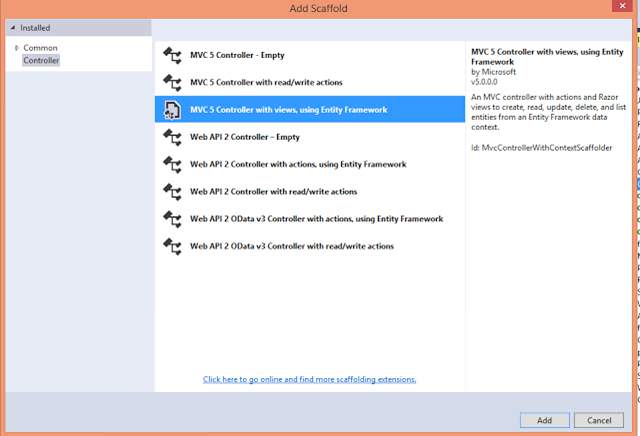在ASP.NET MVC中使用Web API和EntityFramework构建应用程序
2021-02-14 21:17
最近做了一个项目技术预研:在ASP.NET MVC框架中使用Web API和EntityFramework,构建一个基础的架构,并在此基础上实现基本的CRUD应用。
以下是详细的步骤。
第一步
在数据库中创建一张数据表,表名为Customer,见下图:

第二步
打开 Visual Studio,新建项目。
选择‘ASP.NET Web Application‘,命名为‘WebApi‘。

-
我们要创建一个‘Web API‘,在模板中选择‘Web API‘,点击‘确定‘。

第三步
接下来我要添加一个类。
右键点击这个 web api项目,添加一个‘ADO.NET Entity Data Model‘。

添加‘EF Designer from database‘,点击‘下一步‘。

在配置窗口中添加新连接,输入服务器名称,选择数据库,点击‘确定‘。

点击‘下一步‘,选择要关联的数据表。

-
点击‘完成‘。
第四步
现在的工作就是要为Wep Api添加控制器了。
右键选择‘controllers‘文件夹。

选择‘MVC5 Controller with views, using Entity Framework‘。

点击‘添加‘。
选择数据模型类Customer,选择Data context类文件,本例中为SystemTestEntity。
设置控制器名称为CustomersController,点击‘添加‘。

上述操作完成后,CustomerController.cs会自动生成。
CustomerController.cs
using System.Data.Entity;
using System.Data.Entity.Infrastructure;
using System.Linq;
using System.Net;
using System.Web.Http;
using System.Web.Http.Description;
using CRUDWebApiExam.Models;
namespace CRUDWebApiExam.Controllers
{
public class CustomersController : ApiController
{
private SystemTestEntities db = new SystemTestEntities();
// GET: api/Customers
public IQueryable GetCustomer()
{
return db.Customer;
}
// GET: api/Customers/5
[ResponseType(typeof(Customer))]
public IHttpActionResult GetCustomer(int id)
{
Customer customer = db.Customer.Find(id);
if (customer == null)
{
return NotFound();
}
return Ok(customer);
}
// PUT: api/Customers/5
[ResponseType(typeof(void))]
public IHttpActionResult PutCustomer(int id, Customer customer)
{
if (!ModelState.IsValid)
{
return BadRequest(ModelState);
}
if (id != customer.CustomerId)
{
return BadRequest();
}
db.Entry(customer).State = EntityState.Modified;
try
{
db.SaveChanges();
}
catch (DbUpdateConcurrencyException)
{
if (!CustomerExists(id))
{
return NotFound();
}
else
{
throw;
}
}
return StatusCode(HttpStatusCode.NoContent);
}
// POST: api/Customers
[ResponseType(typeof(Customer))]
public IHttpActionResult PostCustomer(Customer customer)
{
if (!ModelState.IsValid)
{
return BadRequest(ModelState);
}
db.Customer.Add(customer);
db.SaveChanges();
return CreatedAtRoute("DefaultApi", new { id = customer.CustomerId }, customer);
}
// DELETE: api/Customers/5
[ResponseType(typeof(Customer))]
public IHttpActionResult DeleteCustomer(int id)
{
Customer customer = db.Customer.Find(id);
if (customer == null)
{
return NotFound();
}
db.Customer.Remove(customer);
db.SaveChanges();
return Ok(customer);
}
protected override void Dispose(bool disposing)
{
if (disposing)
{
db.Dispose();
}
base.Dispose(disposing);
}
private bool CustomerExists(int id)
{
return db.Customer.Count(e => e.CustomerId == id) > 0;
}
}
} 运行这个 Web Api项目,你会看到下面的结果
第五步
到此为止,web api已经构建成功了。接下来我们需要为这个web api服务添加消费对象了,这个消费对象就是本文要涉及的MVC项目。
- 首先要添加一个model类,我们可以直接采用上文中的Customer类。右键点击models文件夹,添加类并命名。本例中,我直接命名为Customer.cs。
Customer.cs
using System;
using System.ComponentModel.DataAnnotations;
namespace MVCPersatantion.Models
{
public class Customer
{
[Display(Name = "CustomerId")]
public int CustomerId { get; set; }
[Display(Name = "Name")]
public string Name { get; set; }
[Display(Name = "Address")]
public string Address { get; set; }
[Display(Name = "MobileNo")]
public string MobileNo { get; set; }
[Display(Name = "Birthdate")]
[DataType(DataType.Date)]
public DateTime Birthdate { get; set; }
[Display(Name = "EmailId")]
public string EmailId { get; set; }
}
} - customer类添加完成后,接下来需要添加一个ViewModel文件夹,并在里面新建一个CustomerViewModel.cs文件。
CustomerViewModel.cs
using MVCPersatantion.Models;
namespace MVCPersatantion.ViewModel
{
public class CustomerViewModel
{
public Customer customer { get; set; }
}
}第六步
我已经添加了一个消费web api服务的类,现在我还需要添加一个Client类。
- 右键点击models文件夹,添加类文件CustomerClient.cs。
CustomerClient.cs
using System;
using System.Collections.Generic;
using System.Net.Http;
using System.Net.Http.Headers;
namespace MVCPersatantion.Models
{
public class CustomerClient
{
private string Base_URL = "http://localhost:30110/api/";
public IEnumerable findAll()
{
try
{
HttpClient client = new HttpClient();
client.BaseAddress = new Uri(Base_URL);
client.DefaultRequestHeaders.Accept.Add(new MediaTypeWithQualityHeaderValue("application/json"));
HttpResponseMessage response = client.GetAsync("customers").Result;
if (response.IsSuccessStatusCode)
return response.Content.ReadAsAsync>().Result;
return null;
}
catch
{
return null;
}
}
public Customer find(int id)
{
try
{
HttpClient client = new HttpClient();
client.BaseAddress = new Uri(Base_URL);
client.DefaultRequestHeaders.Accept.Add(new MediaTypeWithQualityHeaderValue("application/json"));
HttpResponseMessage response = client.GetAsync("customers/" + id).Result;
if (response.IsSuccessStatusCode)
return response.Content.ReadAsAsync().Result;
return null;
}
catch
{
return null;
}
}
public bool Create(Customer customer)
{
try
{
HttpClient client = new HttpClient();
client.BaseAddress = new Uri(Base_URL);
client.DefaultRequestHeaders.Accept.Add(new MediaTypeWithQualityHeaderValue("application/json"));
HttpResponseMessage response = client.PostAsJsonAsync("customers", customer).Result;
return response.IsSuccessStatusCode;
}
catch
{
return false;
}
}
public bool Edit(Customer customer)
{
try
{
HttpClient client = new HttpClient();
client.BaseAddress = new Uri(Base_URL);
client.DefaultRequestHeaders.Accept.Add(new MediaTypeWithQualityHeaderValue("application/json"));
HttpResponseMessage response = client.PutAsJsonAsync("customers/" + customer.CustomerId, customer).Result;
return response.IsSuccessStatusCode;
}
catch
{
return false;
}
}
public bool Delete(int id)
{
try
{
HttpClient client = new HttpClient();
client.BaseAddress = new Uri(Base_URL);
client.DefaultRequestHeaders.Accept.Add(new MediaTypeWithQualityHeaderValue("application/json"));
HttpResponseMessage response = client.DeleteAsync("customers/" + id).Result;
return response.IsSuccessStatusCode;
}
catch
{
return false;
}
}
}
} 细心的朋友们可能已经发现,我的代码中有一些重复代码。实际应用中我们可以抽取成公用代码,这样任何地方都能够使用了。这里为了清楚的阐述过程,所以写了一些重复的代码。
我们看第一行private string Base_URL = "http://localhost:50985/api/",这个Base_URL是web api的服务地址。
接下来就可以编写Insert、Update、Delete、Select的业务逻辑了。
第七步
右键点击Controllers文件夹,添加一个名为Customer控制器,控制器中添加服务客户端调用的方法。
using System;
using System.Collections.Generic;
using System.Linq;
using System.Web;
using System.Web.Mvc;
using MVCPersatantion.Models;
using MVCPersatantion.ViewModel;
namespace MVCPersatantion.Controllers
{
public class CustomerController : Controller
{
// GET: Customer
public ActionResult Index()
{
CustomerClient CC = new CustomerClient();
ViewBag.listCustomers = CC.findAll();
return View();
}
[HttpGet]
public ActionResult Create()
{
return View("Create");
}
[HttpPost]
public ActionResult Create(CustomerViewModel cvm)
{
CustomerClient CC = new CustomerClient();
CC.Create(cvm.customer);
return RedirectToAction("Index");
}
public ActionResult Delete(int id)
{
CustomerClient CC = new CustomerClient();
CC.Delete(id);
return RedirectToAction("Index");
}
[HttpGet]
public ActionResult Edit(int id)
{
CustomerClient CC = new CustomerClient();
CustomerViewModel CVM = new CustomerViewModel();
CVM.customer = CC.find(id);
return View("Edit",CVM);
}
[HttpPost]
public ActionResult Edit(CustomerViewModel CVM)
{
CustomerClient CC = new CustomerClient();
CC.Edit(CVM.customer);
return RedirectToAction("Index");
}
}
} 第八步
创建视图页面Index.cshtml。
在Index页面中添加代码。
Index.cshtml
@{
ViewBag.Title = "Index";
}
Index
@Html.ActionLink("Create", "Create", "Customer", new { area = "" }, null)
CustomerId
Name
Address
MobileNo
Birthdate
EmailId
Action
@foreach (var Cust in ViewBag.listCustomers)
{
@Cust.CustomerId
@Cust.Name
@Cust.Address
@Cust.MobileNo
@Cust.Birthdate.ToString("dd/MM/yyyy")
@Cust.EmailId
Delete ||
Edit
@*@Html.ActionLink("Edit", "Edit", "Customer", new { id = Cust.CustomerId })*@
}
添加新增数据模块Create。
在Customer控制器中添加create方法,在view中增加Create.cshtml。
Create.cshtml
@model WebApiMVC.ViewModel.CustomerViewModel
@{
ViewBag.Title = "Create";
}
Create
@using (Html.BeginForm("create", "Customer", FormMethod.Post))
{
@Html.LabelFor(model => model.customer.Name)
@Html.TextBoxFor(model => model.customer.Name)
@Html.LabelFor(model => model.customer.Address)
@Html.TextBoxFor(model => model.customer.Address)
@Html.LabelFor(model => model.customer.MobileNo)
@Html.TextBoxFor(model => model.customer.MobileNo)
@Html.LabelFor(model => model.customer.Birthdate)
@Html.TextBoxFor(model => model.customer.Birthdate)
@Html.LabelFor(model => model.customer.EmailId)
@Html.TextBoxFor(model => model.customer.EmailId)
}
添加修改数据模块Edit。
在Customer控制器中添加edit方法,在view中增加Edit.cshtml。
Edit.cshtml
@{
ViewBag.Title = "Edit";
}
@model WebApiMVC.ViewModel.CustomerViewModel
Edit
@using (Html.BeginForm("Edit", "Customer", FormMethod.Post))
{
@Html.LabelFor(model => model.customer.Name)
@Html.TextBoxFor(model => model.customer.Name)
@Html.LabelFor(model => model.customer.Address)
@Html.TextBoxFor(model => model.customer.Address)
@Html.LabelFor(model => model.customer.MobileNo)
@Html.TextBoxFor(model => model.customer.MobileNo)
@Html.LabelFor(model => model.customer.Birthdate)
@Html.TextBoxFor(model => model.customer.Birthdate)
@Html.LabelFor(model => model.customer.EmailId)
@Html.TextBoxFor(model => model.customer.EmailId)
返回
@Html.HiddenFor(model => model.customer.CustomerId)
}
最终项目代码已经完成了。这时候我们运行项目试试看了。但还有一点要注意的是,我们必须同时运行web api和mvc项目。怎么办呢?其实只要在项目属性里设置就可以了。
- 右键解决方案,选择属性(Properties)。

接来下在启动项目选项中,选择
多项目启动,在Action中设置两个项目同时启动。运行项目,看看CRUD操作的执行结果。
Select
Insert
Update
Delete
这是整个技术预研的过程,本文末尾位置提供代码下载。
博客地址:http://www.cnblogs.com/yayazi/
本文地址:http://www.cnblogs.com/yayazi/p/8444054.html
声明:本博客原创文字允许转载,转载时必须保留此段声明,且在文章页面明显位置给出原文链接。
源码下载:https://github.com/daivven/WebApiMVC
PS:本人近期打算换工作,目标地点武汉,目标职位.Net软件工程师,期望月薪资12k以上,春节后可参加面试。有没有园友有合适岗位推荐,私信我可发简历,求内推哇~
上一篇:WPF: 实现 ScrollViewer 滚动到指定控件处
下一篇:window
文章标题:在ASP.NET MVC中使用Web API和EntityFramework构建应用程序
文章链接:http://soscw.com/essay/55349.html